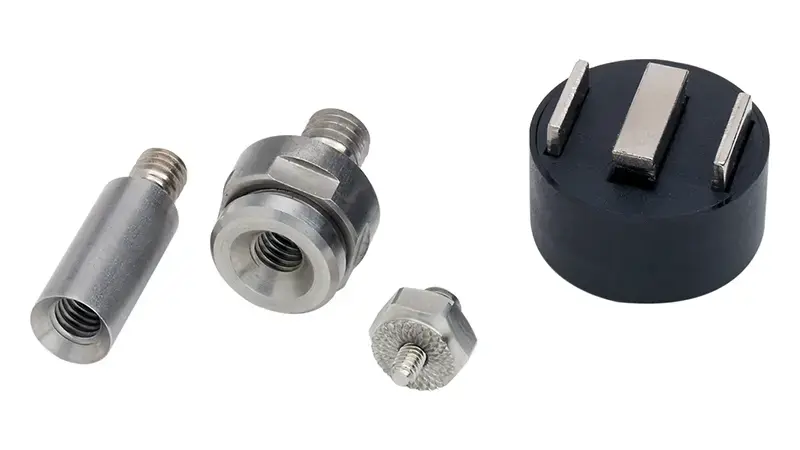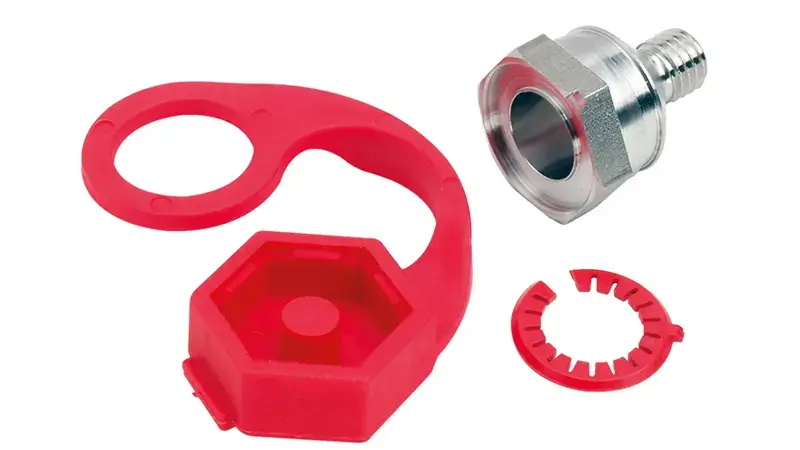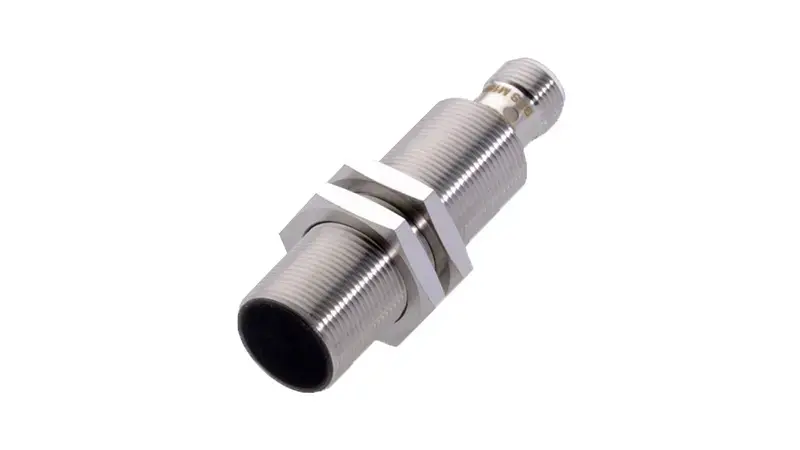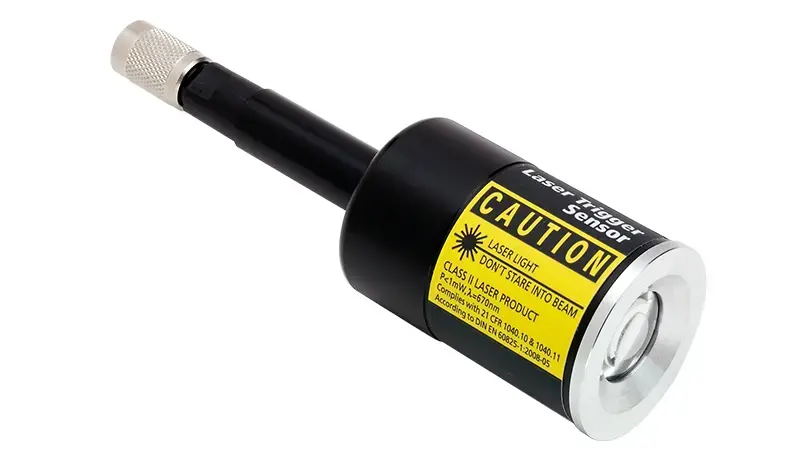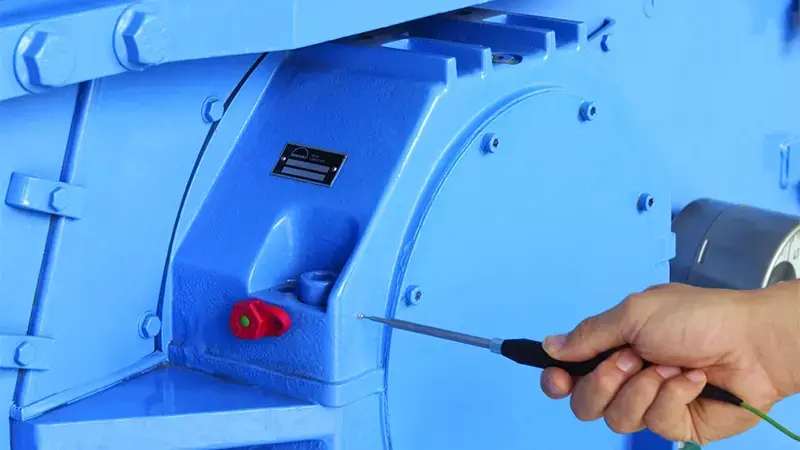用于振动和状态监测的传感器和配件
种类丰富的振动传感器:加速计、位移传感器、VIBCODE 换能器和三轴传感器
加速计测量振动加速度、冲击脉冲(滚柱轴承状态)和泵气蚀
还提供紧凑尺寸,用于低速机器以及用作针对振动和温度的组合传感器
专利 tandem-piezo 技术可克服传统传感器的缺点
通过电流线路驱动 (CLD) 信号放大可实现最远 1,000 米(3,200 英尺)的远距离无损信号传输
多种安装方式
提供 EX / ATEX 版本
提供温度探头、keyphaser、电缆、适配器和工具
产品详情概览
了解详情 …
用于精确和可靠测量的通用振动传感器
工业加速计
状态监测系统用标准加速计
微型传感器
紧凑而经济
型号 VIB 6.202
振动加速度、冲击脉冲(滚柱轴承状态)和泵气蚀
紧凑设计
电缆敷设占用空间小
物美价廉
Tandem-piezo 测量元件
电流线路驱动 (CLD) 信号放大
安装选项:螺栓接合、胶合、磁吸
提供 EX 版本
技术数据(节选)
频率范围 (±3dB) 2 Hz...20 kHz
线性范围 (±10%) 961 ms-²
灵敏度 1µA/ms-²
谐振频率 30 kHz
低速机器
用于低频测量的传感器
型号 VIB 6.172
适用于低转速机器:大于等于 6 U/min (=0.1 Hz)
ICP 电压输出
安装方式:旋紧、粘贴
也可获取防爆型 ICP 传感器
技术数据(节选)
频率范围 (±3dB) 0.1 Hz ...10 kHz
线性范围 < 70 g (r.m.s.) (±1%)
传输因数 100 mV/g
揩振频率 17 kHz
三轴传感器
用于快速数据采集的三轴传感器
VIBXPERT振动分析仪和VIBSCANNER 2数据收集器的VIB类型6.655
同时在 X、Y 和 Z 轴方向进行振动测量
通过螺栓连接或者磁性适配器进行安装
ICP 电压输出
仅适用于 VIBXPERT I 和 VIBXPERT II
技术数据(节选)
频率范围 (±3dB) 0.6 Hz ...10 kHz
线性范围 (±10%) 50g(峰值)
传输因数 100 mV/g
用于轻松数据采集的传感器
该智能传感器总是清楚应在何处测量以及应测量何内容。
振动加速度、冲击脉冲(滚柱轴承状态)和泵气蚀
编码测量位置,确保轻松采集数据
通过卡口架实现稳定连接
可重复结果
Tandem-piezo 技术
电流线路驱动 (CLD) 信号放大
兼容 VIBSCANNER 2 和 VIBXPERT II
测量低速机器上的信号 (>2 Hz)
VIBCODE 是一种智能传感器,可确保即使是未经培训的操作人员也能可靠地采集数据。它可识别所有位置并完全自动执行编程测量,以此提高趋势可靠性并消除由于混合而导致的重复测量。
测量螺柱通过位置编号和测量类型编码。一种获得专利的特殊探头锁定到螺柱,用于测量振动情况和轴承状态(冲击脉冲),并具有卓越的信号传输性能和可重复性。
旋转机器上的轴振动和位移
感应式接近传感器
用于 VIBXPERT 振动分析仪
型号VIB 6.640
感应式接近传感器 VIB 6.640 用于非接触测量指定范围内金属物体的间隙。该传感器连接到 VIBXPERT 振动分析仪。
非接触测量
安装简便
-宽广的线性 / 工作范围
技术数据(节选)
工作范围 Sn:3 ...15 mm
最高频率:300 Hz
感应测量原理
感应式位移传感器
用于在线状态监测系统
型号VIB 6.645 SET
感应式位移传感器 VIB 6.645 SET 连接到普卢福在线系统。该传感器可确定指定范围内金属物体的位置。
非接触测量
安装简便
宽广的线性 / 工作范围
跨整个工作范围的线性电压信号
最高频率较高
LED 调节指示
技术数据(节选)
线性范围:2 ...10 mm
额定工作距离 Se:6 mm
最高频率:500 Hz
测量转速并为基于顺序的振动分析提供基准信号
激光触发器 / 转速传感器
用于普卢福数据采集器
型号 VIB 6.631
适用于便携式 PRUFTECHNIK 测量系统的转速传感器
激光测量
安装和调整简单
转速测量范围广
稳定的三脚架(附件)
可选配防爆型
技术数据(节选)
测量范围:0,1 ... 600 000 U/min
测量距离:0,05 ... 2 m
输出:5V (TTL)
感应式转速传感器
用于普卢福在线监测系统
型号 VIB 5.992-NX
适用于固定式 PRUFTECHNIK 测量系统的标准型转速传感器
感应式测量
安装和校准简单
技术数据(节选)
测量范围:< 150,000 U/min
测量距离:2,3 ... 12 mm
负载电流:200 mA
永久性、手持或磁性温度探头
NiCrNi 传感器
适用于 数据采集器的标准型温度传感器
型号 VIB 8.607-1.5、VIB 8.608
适用于不易够到的测量点
电磁耦合 (VIB 8.607-1.5)
配有探针的手持探头 (VIB 8.608)
测量范围广
也有适用于爆炸危险区域的选型
技术数据(节选)
测量范围:
-50 ... 240°C (VIB 8.607-1.5)
-50 ...500 °C (VIB 8.608)精确度:< 3%
传感器类型:NiCr-Ni 热电偶
合适的配件可确保测量轻松而可靠
安装适配器和工具
适用于固定式系统的电缆、接口和附件
适用于便携式测量仪的电缆和连接适配器
为客户量身定制解决方案
测量系统的质量并不仅仅取决于主要组件,也与所有的系统组件息息相关。研发测量系统时,我们非常重视最优化的测链——从传感器通过信号传输直至信号处理和显示。
由于采用最先进技术,因此能够实现高测量精度
Tandem-Piezo 设计
普卢福专利 Tandem-Piezo 加速度计的独特功能使其适用于几乎所有类型的工业振动应用。
独特的设计真正消除了温度冲击和基础应变效应;它还可以处理涡轮机械和齿轮箱、抗摩擦轴承和泵气蚀的状态评估——所有这些都以同一传感器完成,这要归功于宽线性范围和 36 kHz 下的既定冲击脉冲共振特性。
低基础应变灵敏度、横向灵敏度和对温度瞬变的敏感性
高抗冲击性
集成的共振抑制滤波器可避免放大器过载
工厂局部加厚处理,实现高长期稳定性
电流线路驱动器(CLD)
永久安装的监测系统中使用的长电缆必须经受相当大的电气和机械干扰。在传统传感器中,信号会被噪声和干扰淹没,几乎无法通过网络。
普卢福使用线路驱动系统,该系统由内置于每个传感器中的微型电子放大器组成,以增强振动信号。
对机械和电气干扰(电缆噪声、电磁、接地环路)的敏感度低
可以使用非常长的低成本电缆,信号损失非常小
不受安装过程中电缆定位的影响
沿携带振动信号的同一根同轴电缆传输电源电流(电源来自接收器仪器内置的电源)。
两种类型的线路驱动系统,提供电压输出或电流输出。鉴于其技术优势,普卢福系统使用后者,具有以下优点:
甚至在超过 1,000 米的超长电缆中的高频损耗也要低得多。
对感应噪声和接地环路噪声的敏感性要低得多,在大多数情况下也不需要绝缘传感器。
FAQ
Frequently Asked Questions
What is a Vibration Sensor?
A vibration sensor is a device used to measure the vibrations emitted by equipment and assets. Vibration sensors measure levels of displacement, velocity, and acceleration.
Changes in these measurements that fall outside of a predefined threshold for normal operation can indicate a problem, such as a worn bearing, misaligned parts, or other condition that requires attention. Vibration monitoring is one of the most effective forms of condition monitoring because it can pick up on these problems months before they become serious enough to cause asset failure. This enables maintenance teams to address the problems and schedule maintenance proactively, reducing the risk of unplanned downtime.
Here's how a vibration sensor works: Every piece of rotating equipment has its own vibration signature. When a machine’s normal vibration patterns change, it may indicate a fault. Changes to vibration patterns can reveal a wide array of problems, including looseness, imbalance, or premature wear. Vibration patterns also change when your machine parts are cracked or improperly connected.
Modern vibration sensors can capture and transmit vibration data on a continuous basis, making this data available for analysis in real-time. This makes it easy for your maintenance team to see exactly what’s going on with your assets, so that they can stay a few steps ahead of your maintenance needs.
When used as part of a comprehensive predictive maintenance strategy, vibration sensors can drastically reduce downtime and increase your operation’s productivity.
What are the Different Types of Vibration Sensors?
There are a number of different
types of vibration sensors
on the market, including a variety of vibration sensing technologies, as well as both wireless and wired sensors. It is important to choose a sensor that fits your needs and your budget. The following is a high-level overview of the different types of vibration sensors on the market today.
Accelerometer Vibration Sensors
Accelerometers are the most commonly used kind of vibration sensor. They measure changes in the velocity of your assets’ vibrations.
Accelerometer vibration sensors
are highly sensitive and can pick up on even subtle changes in vibration.
There are many different kinds of accelerometers, including:
Vibration Meters are small, hand-held devices that can measure vibrations on an as-needed basis.
Vibration meters
often do not directly attach to your machinery, though some can be configured that way. Instead, technicians use them as part of routine inspections. Vibration meters often include accelerometers.
Vibration meters are convenient and accurate. However, they cannot provide data on a continuous basis, the way wireless vibration sensors can. This means that vibration meters alone can’t enable a predictive maintenance strategy.
MEMs Vibration Sensors are widely used because of their frequency response. They excel at picking up vibration frequencies between 0 and 1,000 hertz. Changes in those lower frequencies typically point to problems with imbalance, misalignment, and looseness. MEMs sensors are also cost-effective, offer a long battery life, and have high IP ratings for reliable operation in wet or dusty industrial environments.
Piezoelectric vibration sensors, also known as piezo sensors, are often lauded for their performance even in extreme environments. Piezoelectric vibration sensors also pick up on higher frequencies, especially frequencies above 1,000 hertz. Changes in these higher frequencies usually indicate problems with gearboxes and motor bars.
What is a Piezoelectric Vibration Sensor?
Piezoelectric vibration sensors use the piezoelectric effect to measure vibration by converting it into an electrical charge. These sensors rely on piezoelectric elements – usually quartz crystals – to convert the mechanical energy caused by vibrations into electrical signals.
Your technicians will place piezoelectric sensors directly on your equipment or component parts. As the asset vibrates, that movement creates an electrical charge across the piezoelectric element.
Piezo vibration sensors are probably the most widely used form of accelerometer because of their resilience, versatility, and ability to operate in harsh environments.
Why use an industrial vibration sensor?
In the past, vibration sensors were primarily used for large-scale equipment like HVACs. Today, there is more pressure than ever on manufacturers to keep up their production schedules on target and minimize downtime. Most operations are also using more assets than ever before. This makes it more challenging and complex to perform routine inspections.
As a result, more and more industrial operations have started using vibration sensors to monitor the health of their equipment. Vibration sensors alert you to potential problems like misalignment, imbalance, looseness, and gear issues. In many cases, the sensors flag these conditions months before they turn into major problems. That allows your maintenance team to get in and fix the issue ahead of time.
Vibration sensors are a key part of any condition monitoring or predictive maintenance strategy. They allow you to keep tabs on your equipment without forcing you to shut down operations for routine inspections.
You’ll know exactly when and where to replace belts, lubricate parts, or perform other routine maintenance tasks. Ultimately, you’ll save on maintenance costs and maximize your uptime and productivity.
Where do I install vibration sensors?
It’s generally a good idea to install vibration sensors on your critical assets. Vibration sensors can track the health of all of your rotating equipment, including
Motors
Fans and belts
Pumps
Gearboxes
Conveyor systems
Automated assembly lines
Chillers
When first piloting a condition monitoring program, start by installing vibration sensors on the equipment that you rely on to maintain production levels. Install the sensors as close as possible your motor, pump, and shaft bearings. If you’re not sure where or how to mount your sensors, it’s a good idea to consult with condition monitoring experts.
下載更多信息
小冊
證書
-
![]() VIB 6.2yy zz XD Minisensor
VIB 6.2yy zz XD Minisensor
Certificate | EX
-
![]() VIB 6.631 EX Laser Trigger Sensor
VIB 6.631 EX Laser Trigger Sensor
Certificate | EX
-
![]() VIB 8.660 EX VIBCODE 1.Supplement
VIB 8.660 EX VIBCODE 1.Supplement
Certificate | EX
-
![]() VIB 2.25x | 2.26x | 3.57y-x | 4.70y-x | 4.750-5 | 5.13x | 5.2xy | 5.322-x | 5.330wxyz | 5.33x | 5.34x | 5.345-6 | 5.346-MUX | 5.422 cable CM
VIB 2.25x | 2.26x | 3.57y-x | 4.70y-x | 4.750-5 | 5.13x | 5.2xy | 5.322-x | 5.330wxyz | 5.33x | 5.34x | 5.345-6 | 5.346-MUX | 5.422 cable CM
Declaration of conformity | CE
-
![]() VIB 5.332 X Keyphaser adapter for protection system
VIB 5.332 X Keyphaser adapter for protection system
Declaration of conformity | CE
-
![]() VIB 5.341...344 Adapters for VIBXPERT II
VIB 5.341...344 Adapters for VIBXPERT II
Declaration of conformity | CE
-
![]() VIB 5.433 X Adapter cable for extra low voltage VIBXPERT EX
VIB 5.433 X Adapter cable for extra low voltage VIBXPERT EX
Declaration of conformity | CE
-
![]() VIB 6.164-10 | 6420-L | 6.426-L | 6.640 | 6.675 | 7.115-x | 7.832-5 | 8.618-x | 8.619 | 8.619-USB 321926-2 cable CM
VIB 6.164-10 | 6420-L | 6.426-L | 6.640 | 6.675 | 7.115-x | 7.832-5 | 8.618-x | 8.619 | 8.619-USB 321926-2 cable CM
Declaration of conformity | CE
-
![]() VIB 6.172 ICP Beschleunigungsaufnehmer
VIB 6.172 ICP Beschleunigungsaufnehmer
Declaration of conformity | CE
-
![]() VIB 6.195 CLD Accelerometer
VIB 6.195 CLD Accelerometer
Declaration of conformity | CE
-
![]() VIB 6.1xy Ind. Accelerometer with intrinsic safety
VIB 6.1xy Ind. Accelerometer with intrinsic safety
Declaration of conformity | CE
-
![]() VIB 6.1xy Industrial Accelerometer
VIB 6.1xy Industrial Accelerometer
Declaration of conformity | CE
-
![]() VIB 6.202 - 203 Mini acceleration Sensor
VIB 6.202 - 203 Mini acceleration Sensor
Declaration of conformity | CE
-
![]() VIB 6.20y-zzXD Mini acceleration Sensor
VIB 6.20y-zzXD Mini acceleration Sensor
Declaration of conformity | CE
-
![]() VIB 6.210 ICP-Sensor with M-12 connection
VIB 6.210 ICP-Sensor with M-12 connection
Declaration of conformity | CE
-
![]() VIB 8.619-USB Serial to USB cable adapter for VIBROTIP EX
VIB 8.619-USB Serial to USB cable adapter for VIBROTIP EX
Declaration of conformity | CE
-
![]() VIB 8.660 HEX VIBCODE without cable dust explosion proof
VIB 8.660 HEX VIBCODE without cable dust explosion proof
Declaration of conformity | CE
-
![]() VIB 8.660 VIBCODE without cable
VIB 8.660 VIBCODE without cable
Declaration of conformity | CE
-
![]() VIB 6.221 Beschl.sensor Hybrid Triaxial mobil
VIB 6.221 Beschl.sensor Hybrid Triaxial mobil
符合性聲明 | CE
手册
-
![]() RPM sensor
RPM sensor
操作说明
-
![]() Switchbox VIB 6.785 installation
Switchbox VIB 6.785 installation
Manual
-
![]() VIB 6.12x – VIB 6.14x Industrial accelerometer
VIB 6.12x – VIB 6.14x Industrial accelerometer
Manual
-
![]() VIB 6.210 – VIB 6.172 IEPE sensor
VIB 6.210 – VIB 6.172 IEPE sensor
Manual
-
![]() VIB 6.221 Triaxial sensor
VIB 6.221 Triaxial sensor
Manual
-
![]() VIB 6.2x mini sensor
VIB 6.2x mini sensor
Manual
-
![]() VIBCODE
VIBCODE
Manual
-
![]() VIBCODE Repair instruction
VIBCODE Repair instruction
Manual
-
![]() VIBCODE Test instruction
VIBCODE Test instruction
Manual
-
![]() VIBCODE - Instructions for adhesive mounting
VIBCODE - Instructions for adhesive mounting
Manual
-
![]() VIB 6.163 Online Combi sensor
VIB 6.163 Online Combi sensor
Manual
-
![]() VIB 6.195 CLD Wind sensor
VIB 6.195 CLD Wind sensor
Manual
-
![]() 振动传感器安全信息
振动传感器安全信息
操作说明
-
![]() VIB 6.520 加速度计
VIB 6.520 加速度计
操作说明



 Fluke Corporation
Fluke Corporation 


